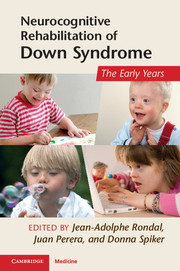Book contents
- Frontmatter
- Contents
- List of contributors
- Preface
- Acknowledgments
- Section 1 Definition, history, methodology, and assessment
- Section 2 Genetics, brain, and animal models
- Section 3 Pharmacological and medical management and treatment
- 7 Pharmacotherapy for children with Down syndrome
- 8 Early medical caretaking and follow-up
- 9 Evaluation and management of cardiovascular diseases in Down syndrome
- Section 4 Early development and intervention
- Section 5 Therapeutic perspectives
- Conclusions
- Index
- References
8 - Early medical caretaking and follow-up
Published online by Cambridge University Press: 05 July 2011
- Frontmatter
- Contents
- List of contributors
- Preface
- Acknowledgments
- Section 1 Definition, history, methodology, and assessment
- Section 2 Genetics, brain, and animal models
- Section 3 Pharmacological and medical management and treatment
- 7 Pharmacotherapy for children with Down syndrome
- 8 Early medical caretaking and follow-up
- 9 Evaluation and management of cardiovascular diseases in Down syndrome
- Section 4 Early development and intervention
- Section 5 Therapeutic perspectives
- Conclusions
- Index
- References
Summary
Introduction
Down syndrome (DS) is caused by trisomy of chromosome 21 and is the most common autosomal disorder in man, occurring in approximately 1/1000 newborns. Main phenotypic traits are cognitive and language impairment, neuromotor dysfunction, growth reduction, congenital heart disease, immune dysfunction and autoimmune disorders, early ageing and pathological ageing. These traits can be associated with various diseases that are partly responsible for shorter life in people with DS and for the appearance of secondary disability, which greatly affects their well-being.
The main concern of clinicians who care for children with DS is to prevent or to treat these diseases, as early as possible, in order to hamper the appearance of severe clinical consequences.
The concept of early caretaking in its common meaning is early in life – even in prenatal life, as it has been recently suggested – but another meaning can be important as well: that of early medical intervention in relation to the course of the diseases.
In the last 30 to 40 years, DS experienced outstanding changes in quality and duration of life, the causes of which are numerous and can be exemplified in early rehabilitation, in more diffuse social integration, including life in one's own family, participation in mainstream schooling and employment, and last but not least, in more sensible and accurate medical care from birth and throughout life.
A brief survey of some of the most common diseases and their treatment, pointing out early medical intervention and its meaning, follows.
- Type
- Chapter
- Information
- Neurocognitive Rehabilitation of Down SyndromeEarly Years, pp. 117 - 127Publisher: Cambridge University PressPrint publication year: 2011



